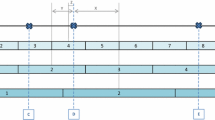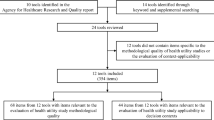Abstract
To test the ‘home-country weights hypothesis’: that the validity of cost utility analyses is improved if utility is measured using an instrument with utility weights obtained from people living in the ‘home-country’—the same country as the patients who are to receive the service which is being evaluated. The convergent validity of multi attribute utility instruments (MAUI) with and without home-country weights was compared. Comparisons were made within and between countries. The analyses employed data from 7933 individuals in 6 Western countries, each of whom completed the questionnaires of 5 MAUI; the EQ-5D-5L, SF-6D, HUI 3, 15D and AQoL-8D. Convergent validity was not greater when an MAUI had home-country weights. Differences in national traits between culturally similar countries may be too small or subtle to affect the utility scores estimated from existing MAUI. This implies that the choice of an MAUI for economic evaluation in culturally similar countries should not be based upon the country in which utility weights were estimated but upon a broader consideration of an instrument’s construct validity.

Similar content being viewed by others
References
AQoL. (2018). Assessment of Quality of Life (AQoL). https://www.monash.edu/business/che/aqol. Accessed 25 July, 2018.
Badia, X., Roser, M., Herdman, M., & Kind, P. (2001). A comparison of United Kingdom and Spanish general population time trade-off values for EQ-5D health states. Medical Decision Making, 21, 7–16.
Bansback, N., Tsuchiya, A., Brazier, J., & Anis, A. (2012). Canadian valuation of EQ-5D health states: Preliminary value set and considerations for future valuation studies. PLoS ONE, 7(2), e31115.
Bowling, A. (2005). Measuring health: A review of Quality of Life Measurement Scales. Maidenhead, Berkshire: Open University Press.
Brazier, J., Ratcliffe, J., Salomon, J., & Tsuchiya, A. (2017). Measuring and valuing health benefits for economic evaluation (2nd ed.). Oxford: Oxford University Press.
Brazier, J., Roberts, J., & Deverill, M. (2002). The estimation of a preference-based measure of health from the SF-36. Journal of Health Economics, 21, 271–292.
CADTH. (2006). Guidelines for the economic evaluation of health technologies: Canada (3rd ed.). Ottawa: Canadian Agency for Drugs and Technologies in Health. https://www.cadth.ca/about-cadth/how-we-do-it/methods-and-guidelines/guidelines-for-the-economic-evaluation-of-health-technologies-canada. Accessed 22 Feb 2019.
Devlin, N., Shah, K. K., Mulhern, B., & van Hout, B. (2017). Valuing health-related quality of life: An EQ-5D-5L value set for England. Health Economics. https://doi.org/10.1002/hec.3564.
Dolan, P., Gudex, C., Kind, P., & Williams, A. (1996). The time trade-off method: Results from a general population study. Health Economics, 5, 141–154.
Fang, M., Oremus, M., Tarride, J.-E., Raina, P., & Canadian Willingness-to-pay Study Group. (2016). A comparison of health utility scores calculated using United Kingdom and Canadian preference weights in persons with Alzheimer’s disease and their caregivers. Health and Quality of Life Outcomes, 14, 105. https://doi.org/10.1186/s12955-016-0510-y.
Fayers, P. M., & Machin, D. (2000). Quality of life: Assessment, analysis and interpretation. Chichester: Wiley.
Feeny, D., Furlong, W., Torrance, G., Goldsmith, C., Zhu, Z., DePauw, S., et al. (2002). Multi attribute and single attribute utility functions for the Health Utilities Index Mark 3 System. Medical Care, 40(2), 113–128.
Finch, A. P., Brazier, J. E., & Mukuria, C. (2017). What is the evidence for the performance of generic preference-based measures? A systematic overview of reviews. The European Journal of Health Economics. https://doi.org/10.1007/s10198-017-0902-x.
Galante, J., Augustovski, F., Colantonia, L., Bardach, A., Caporale, J., Garcia, M., et al. (2011). Estimation and comparison of EQ-5D health states’ utility weights for pneumococcal and human papillomavirus disease in Argentina, Chile, and the United Kingdom. Value in Health, 14, S60–S64. https://doi.org/10.1016/jval.2011.05.007.
Greiner, W., Claes, C., Busschbach, J., & Graf von der Schulenburg, J. M. (2005). Validating the EQ-5D with time trade off for the German population. European Journal of Health Economics, 6(2), 124–130.
Johnson, J. A., Luo, N., Shaw, J. W., Kind, P., & Coons, S. J. (2005). Valuatioosn of EQ-5D health states: Are the United States and United Kingdom different? Medical Care, 43(3), 221–228.
Knies, S., Evers, S. M., Candel, M. J., Severens, J. L., & Ament, A. J. (2009). Utilities of the EQ-5D: Transferable or not? Pharmacoeconomics, 27(9), 767–779. https://doi.org/10.2165/11314120-000000000-00000.
Lamers, L. M., McDonnell, J., Stalmeier, P. F. M., Krabbe, P. F. M., & Busschbach, J. (2006). The Dutch tariff: Results and arguments for an effective design for national EQ-5D valuation studies. Health Economics, 15, 1121–1132.
Lien, K., Tam, V. C., Ko, Y. J., Mittman, N., Cheung, M. C., & Chan, K. K. W. (2015). Impact of country-specific EQ-5D-3L tariffs on the economic value of systemic therapies used in the treatment of metastatic pancreatic cancer. Oncology, 22(6), e443–e452.
Liu, L. (2017). Comparison of EQ-5D-5L health state utilities using four country-specific tariffs on a breast cancer patient sample in mainland China. Patient Preference and Adherence, 11, 1049–1056.
Luo, N., Johnson, J., Shaw, J. W., & Coons, S. J. (2007). A comparison of EQ-5D index scores derived from the US and UK population based scoring functions. Medical Decision Making, 27, 321–326.
Maxwell, A., Özmen, M., Iezzi, A., & Richardson, J. (2016). Deriving population norms for the AQoL-6D and AQoL-8D multi attribute utility instruments. Quality of Life Research, 25(13), 3209–3219. https://doi.org/10.1007/s11136-016-1337-z.
McDowell, I. (2006). Measuring health: A guide to rating scales and questionnaires. Oxford: Oxford University Press.
Mozzi, A., Meregaglia, M., Lazzafro, C., Tornatore, V., Belfigliio, M., & Fattore, G. (2016). A comparison of EuroQol 5-Dimension health related utilities using Italian, UK and US preference weights in a patient sample. ClinicoEconomics and Outcomes Research, 8, 267–274.
NICE. (2013). Guide to the methods of technology appraisal 2013. National Institute for Health and Clinical Excellence. https://www.nice.org.uk/process/pmg9/chapter/foreword. Accessed 22 Feb 2019.
Norman, R., Cronin, P., Viney, R., King, M. T., Street, D., & Ratcliffe, J. (2009). International comparisons in valuing EQ-5D health states: A review and analysis. Value in Health, 12, 1194–1200.
Norman, R., Viney, R., Brazier, J., Burgess, L., Cronin, P., King, M., et al. (2013). Valuing SF-6D health states using a discrete choice experiment. Medical Decision Making, 11(34), 773–786. https://doi.org/10.1177/0272989x13503499.
Noyes, K., Dick, A. W., & Holloway, R. G. (2007). The implications of using US-specific EQ-5D preference weights for cost effectiveness evaluation. Medical Decision Making, 27, 327–334.
Patrick, D. L., & Erickson, P. (1993). Health status and health policy: Allocating resources to health care. New York: Oxford University Press.
PBAC. (2013). Guidelines for preparing submissions to the Pharmaceutical Benefits Advisory Committee (Version 4.4). Canberra: Australian Government, Department of Health. https://pbac.pbs.gov.au/information/printable-version-of-guidelines.html. Accessed 22 Feb 2019.
PHARMAC. (2015). Prescription for pharmacoeconomics analysis: Methods for cost utility analysis. New Zealand. https://www.pharmac.govt.nz/medicines/how-medicines-are-funded/economic-analysis/. Accessed 22 Feb 2019.
Richardson, J. (2010). Psychometric validity and multi attribute utility (MAU) instruments. Research paper 57. Melbourne: Centre for Health Economics, Monash University.
Richardson, J., Cummins, R. A., Olsen, J. A., Kaplan, R., Coast, J., & Schlander, M. (2015a). The multi instrument comparison (MIC) project. AQoL. http://www.aqol.com.au/index.php/aqol-current. Accessed 22 Feb 2019.
Richardson, J., Iezzi, A., & Khan, M. A. (2015b). Why do multi attribute utility instruments produce different utilities: The relative importance of the descriptive systems, scale and ‘micro utility’ effects. Quality of Life Research, 24(8), 2045–2053. https://doi.org/10.1007/s11136-015-0926-6.
Richardson, J., Khan, M. A., Iezzi, A., & Maxwell, A. (2012). Cross-national comparison of twelve quality of life instruments. Research Papers 78, 80–83, 85. MIC Report: 2: Australia; 3: UK; 4: USA; 5: Canada; 6: Norway; 7: Germany. Melbourne: Centre for Health Economics, Monash University. https://www.monash.edu/business/che/our-research/publications. Accessed 22 Feb 2019.
Richardson, J., Khan, M. A., Iezzi, A., & Maxwell, A. (2015c). Comparing and explaining differences in the content, sensitivity and magnitude of incremental utilities predicted by the EQ-5D, SF-6D, HUI 3, 15D, QWB and AQoL-8D multi attribute utility instruments’. Medical Decision Making, 35(3), 276–291. https://doi.org/10.1177/0272989X14543107.
Richardson, J., McKie, J., & Bariola, E. (2014). Multi attribute utility instruments and their use. In A. J. Culyer (Ed.), Encyclopedia of health economics (pp. 341–357). San Diego: Elsevier.
Richardson, J., Sinha, K., Iezzi, A., & Khan, M. (2011). Modelling the utility of health states with the Assessment of Quality of Life (AQoL) 8D instrument: Overview and utility scoring algorithm. Research Paper 63. Melbourne: Centre for Health Economics, Monash University.
Sakthong, P., Charoenvisuthiwongs, R., & Shabunthom, R. (2008). A comparison of EQ-5D index scores using the UK, US and Japan preference weights in a Thai sample with type 2 diabetes. Health and Quality of Life Outcomes, 6, 71. https://doi.org/10.1186/1477-7525-6-71.
Sintonen, H., & Pekurinen, M. (1993). A fifteen-dimensional measure of health related quality of life (15D) and its applications. In S. Walker & R. Rosser (Eds.), Quality of life assessment. Dordrecht: Kluwer.
Streiner, D., & Norman, G. R. (2003). Health measurement scales: A practical guide to their development and use. Oxford: Oxford University Press.
Tsuchiya, A., Ikeda, S., Ikegami, N., Nishimura, S., Sakai, I., Fukuda, T., et al. (2002). Estimating an EQ-5D populatin value set: The case of Japan. Health Economics, 11, 341–353.
van Hout, B., Janssen, M. F., Feng, Y., Kohlmann, T., Busschbach, J., Golicki, D., et al. (2012). Interim scoring for the EQ-5D-5L: Mapping the EQ-5D-5L to EQ-5D-3L value sets. Value in Health, 15, 708–715.
van Hout, B., Krabbe, P., Kind, P., & Mulhern, B. (2011). Innovative responses to methodological challenges. Paper presented at the ISPOR 2011, workshop valuing health in economic evaluations, Madrid.
Wee, H.-L., Machin, D., Loke, W.-C., Li, S.-C., Cheung, Y.-B., Luo, N., et al. (2007). Assessing differences in utility scores: A comparison of four widely used preference-based instruments. Value in Health, 10(4), 256–265. https://doi.org/10.1111/j.1524-4733.2007.00174.x.
Zhao, Y., Li, S.-P., Liu, L., Zhang, J.-L., & Chen, G. (2017). Does the choice of tariff matter? A comparison of EQ-5D-5L utility scores using Chinese, UK and Japanese tariffs on patients with psoriasis vulgaris in Central South China. Medicine, 96(34), e7840. https://doi.org/10.1097/MD.0000000000007840.
Funding
Financial support for this study was provided entirely by a grant from the National Health and Medical Research Council (NH&MRC) Project Grant ID 1006334.
Author information
Authors and Affiliations
Corresponding author
Ethics declarations
Conflict of interest
The authors report no conflict of interest.
Additional information
Publisher's Note
Springer Nature remains neutral with regard to jurisdictional claims in published maps and institutional affiliations.
Electronic supplementary material
Below is the link to the electronic supplementary material.
Rights and permissions
About this article
Cite this article
Khan, M.A., Richardson, J. Is the Validity of Cost Utility Analysis Improved When Utility is Measured by an Instrument with ‘Home-Country’ Weights? Evidence from Six Western Countries. Soc Indic Res 145, 1–15 (2019). https://doi.org/10.1007/s11205-019-02094-z
Accepted:
Published:
Issue Date:
DOI: https://doi.org/10.1007/s11205-019-02094-z




